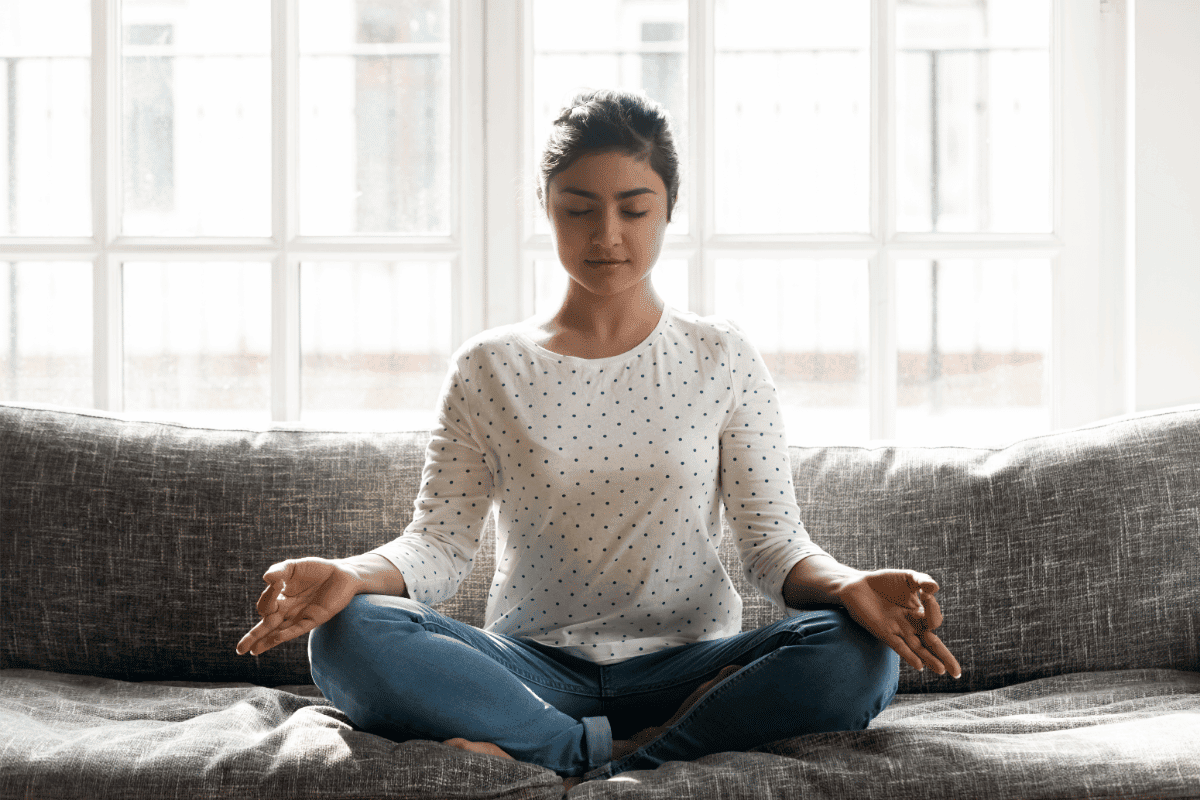10 Mindfulness Exercises for a Calm and Present Mind
Welcome to the world of mindfulness! In today’s fast-paced world, it’s easy to get caught up in the hustle and bustle of everyday life. Our minds can feel cluttered with endless to-do lists, distractions, and anxieties, making it difficult to stay present in the moment and find inner peace. That’s where mindfulness exercises come in.
Mindfulness exercises are techniques designed to help you cultivate a sense of awareness, focus, and calm. By practicing mindfulness activities, you can experience a profound shift in your mindset, allowing you to be more present in the moment and find greater clarity and inner peace.
In this article, we’ll explore 10 powerful mindfulness techniques that you can use to cultivate a calm and present mind. From meditation exercises to mindful walking, body scan meditation, and more, these mindfulness exercises will help you achieve greater mental and emotional well-being.
Understanding Mindfulness and Its Benefits
Welcome to the world of mindfulness practice. Mindfulness is the practice of focusing attention on the present moment, without judgment, and with an attitude of curiosity and kindness. It is a way of being that promotes a calm and present state of mind. In today’s fast-paced world, mindfulness techniques are becoming increasingly important as a means of managing stress and improving overall mental well-being.
Mindfulness practice has numerous benefits. Studies have shown that it can reduce stress, anxiety, and depression, and improve cognitive function and emotional regulation. It can also enhance relationships, increase happiness, and promote a sense of overall well-being.
Understanding Mindfulness Techniques
Mindfulness techniques can take many different forms, from meditation exercises to simple everyday activities. The key is to tune in to the present moment, becoming aware of your thoughts, feelings, and bodily sensations without judgment. Here are some examples of mindfulness techniques you can try:
- Mindful breathing: This involves focusing on your breath and bringing your attention back to it whenever your mind wanders.
- Body scan meditation: A body scan meditation involves paying attention to each part of your body, from your toes to your head, and observing any sensations you feel.
- Mindful walking: This involves walking slowly and mindfully, tuning in to the sensations in your feet, legs, and body as you move.
- Guided mindfulness exercises: There are many guided mindfulness exercises available, from apps to podcasts, that can help you deepen your practice.
- Mindfulness activities for daily life: You can also practice mindfulness during your daily activities, such as eating, showering, and commuting.
These are just a few examples of the many mindfulness techniques available. The key is to find the ones that work best for you and make them a regular part of your daily routine.
Mindfulness practice takes time and commitment, but the rewards are well worth it. By cultivating a mindfulness practice, you can develop a deeper sense of awareness, a greater ability to cope with stress, and a more fulfilling and meaningful life.
Mindful Breathing Exercise
Mindful breathing is a simple yet powerful exercise that can help you cultivate a sense of calm and focus in any situation. It involves bringing your attention to your breath and observing it without judgment.
To begin, find a comfortable seated position and close your eyes. Take a few deep breaths in through your nose and out through your mouth, allowing any tension to release from your body. Then, let your breath settle into its natural rhythm.
As you focus on your breath, bring your attention to the sensation of the air moving in and out of your nostrils. Notice how your chest and abdomen expand and contract with each inhale and exhale.
If your mind begins to wander, gently redirect your attention back to your breath without judgment. You can also try counting your breaths or silently repeating a phrase like “inhale, exhale” to help anchor your attention.
Practice this exercise for 5-10 minutes each day, gradually increasing the length of time as you become more comfortable with the practice. Mindful breathing can be done anywhere, anytime, making it a convenient tool for reducing stress and increasing presence in daily life.
Mindful Body Scan Meditation
Feeling tense or overwhelmed? A mindful body scan meditation may be just what you need. This mindfulness exercise involves bringing your full attention to different parts of your body, releasing tension and promoting relaxation.
Begin by finding a comfortable position, either lying down or seated. Close your eyes or soften your gaze, and take several deep breaths to ground yourself and clear your mind.
| Steps for Mindful Body Scan Meditation |
|---|
| Start at the top of your head and slowly scan down your body, paying attention to any areas of discomfort, tension, or pain. |
| As you focus on each part of your body, consciously release any tension you may be holding there. Breathe deeply into each area and imagine sending healing energy to that part of your body. |
| Continue to move down your body in this way until you reach your toes. |
| After completing the full body scan, take a few moments to simply observe any sensations and feelings that arise. Allow yourself to be fully present in your body. |
Practicing a mindful body scan meditation can help you tune in to your body’s needs and release any built-up tension or stress. Incorporate this practice into your daily routine to cultivate a more present and peaceful state of mind.
Mindful Walking: Bringing Awareness to Each Step
Mindful walking is a simple yet powerful mindfulness exercise that can be practiced anywhere. It involves bringing full attention to each step and noticing the sensations in the body as you walk. Mindful walking can help clear the mind, reduce stress, and strengthen the mind-body connection.
To practice mindful walking, find a quiet and safe location where you can walk without distractions. Start by standing still, taking a few deep breaths, and bringing your attention to the present moment. Begin walking at a slow and steady pace, being mindful of the sensation of your feet touching the ground.
As you walk, pay attention to the movement of your legs, the shifting of your weight, and the feeling of your muscles contracting and releasing. Notice the sensations in your feet, such as the pressure of each step and the texture of the ground beneath you. If your mind wanders, gently bring it back to the physical sensations of walking.
Try to maintain a calm and relaxed state, breathing deeply and evenly. Focus on your breathing and the rhythm of your steps. You may find it helpful to count your steps, syncing your breath to your pace.
Finally, as you come to the end of your walk, take a moment to pause and reflect on your experience. Notice how you feel, both physically and mentally. Over time, regular practice of mindful walking can help improve focus, reduce stress, and cultivate a sense of calm and presence in daily life.
Guided Mindfulness Exercises
Guided mindfulness exercises can be a helpful tool for those looking to deepen their practice. These exercises provide a structured meditation session that can help to calm the mind, reduce stress, and increase overall well-being. Additionally, guided meditations can be useful for those who find it challenging to meditate on their own, providing an external source of guidance and support.
There are numerous resources available for guided mindfulness exercises, including apps, online videos, and audio recordings. When selecting a guided meditation, it is essential to choose one that resonates with you, considering the tone of the speaker and the style of the practice.
Many guided meditations focus on various mindfulness exercises, such as mindful breathing or body scan meditation, providing step-by-step guidance on how to engage in the practice. Other exercises may focus on cultivating specific mental or emotional states, such as kindness or gratitude, to enhance overall well-being.
One of the significant benefits of guided mindfulness exercises is the flexibility they offer. They can be done at any time, in any location, and for any duration. This flexibility allows individuals to customize their mindfulness practice to their own needs, making it more accessible and enjoyable.
For those interested in trying guided mindfulness exercises, there are many online resources available. Popular apps and websites for guided meditations include Headspace, Calm, and Insight Timer. Alternatively, there are numerous free guided meditations available on the internet, making it accessible for anyone to try.
Whether you are new to mindfulness or looking to deepen your practice, guided mindfulness exercises can be a valuable resource. Incorporating guided meditations into your routine can help to cultivate a sense of calm and focus, enhancing overall well-being and allowing you to approach life with greater intention and clarity.
Mindfulness Activities for Daily Life
Mindfulness is a practice that can be integrated into daily life, making it more meaningful and enjoyable. Here are some ways to incorporate mindfulness activities into your daily routine:
- Mindful Eating: Take time to savor each bite, notice the flavors and textures, and appreciate the nourishment it provides your body.
- Mindful Showering: Focus on the sensation of water on your skin, the smell of the soap, and the warmth of the water.
- Mindful Commuting: Use your commute time to practice deep breathing exercises, or simply observe the world around you.
- Mindful Walking: Take a break from your desk and go for a walk. Focus on the sensation of your feet on the ground, the movement of your body, and the scenery around you.
- Mindful Listening: When someone is speaking to you, give them your full attention. Listen to their words, tone of voice, and body language.
By incorporating mindfulness activities into your daily routine, you can reduce stress, improve focus, and find greater enjoyment in the present moment. Start with one activity at a time, and gradually integrate more into your day.
Mindfulness Techniques for Stress Reduction
Stress is an unavoidable part of modern life, but mindfulness techniques can help you manage stress and reduce its impact on your mental and physical health. These mindfulness exercises can help you cultivate a calm and centered mind, even in the midst of chaos.
Loving-Kindness Meditation
One powerful way to reduce stress is by practicing loving-kindness meditation. This mindfulness exercise involves directing positive thoughts and feelings toward yourself and others. Begin by finding a quiet, comfortable place to sit and close your eyes. Take a few deep breaths and then focus on a person you love or care deeply about. Visualize them in your mind and silently repeat the following phrases:
- May you be happy
- May you be healthy
- May you be safe and protected
- May you live with ease and well-being
As you progress through the exercise, extend these positive wishes to yourself, then to someone you feel neutral about, then to someone you may have difficulty with. Remember, this is not about changing anyone’s behavior, but rather about cultivating positive feelings and intentions toward all beings.
Gratitude Exercises
Another effective mindfulness technique for reducing stress is gratitude exercises. Focusing on what you are thankful for can shift your mindset from one of stress and worry to one of abundance and positivity. One simple exercise is to write down three things you are grateful for each day. These can be big or small, but should be things that bring you joy or happiness. Over time, this practice can help you cultivate a greater sense of contentment and well-being.
Mindful Journaling
Journaling can be a powerful way to reduce stress and gain insight into your thoughts and emotions. Mindful journaling involves writing down your thoughts and experiences in a non-judgmental and reflective way. Start by finding a quiet place to write and set aside at least 10-15 minutes for the exercise. Write down anything that comes to mind – worries, fears, hopes, and aspirations. Allow yourself to explore your thoughts and feelings without judgment or criticism. You may find that this practice helps you gain greater clarity and perspective on your life.
By incorporating these mindfulness techniques into your daily routine, you can reduce stress and cultivate a greater sense of well-being and inner peace. Remember, mindfulness is a practice, so be patient and kind with yourself as you explore these exercises. The benefits of mindfulness come with time and consistent effort.
Mindfulness Exercises for Improved Focus and Productivity
Do you struggle to stay focused when working or completing tasks? Are you easily distracted and find yourself procrastinating? Incorporating mindfulness exercises into your daily routine can help improve your focus and productivity. By intentionally bringing awareness to your thoughts and actions, you can cultivate a greater sense of presence and concentration.
Mindful Eating
Mindful eating is the practice of bringing full attention to the experience of eating. When we eat mindlessly, we often rush through meals, barely even tasting the food. By contrast, mindful eating involves savoring each bite, paying attention to the flavors, textures, and sensations of the food.
To practice mindful eating, start by sitting down to a meal with no distractions, such as phones or television. Take a few deep breaths, then begin eating slowly, paying attention to each bite. Notice the flavors and textures of the food, and how it makes you feel.
Deep Breathing Exercises
Deep breathing exercises can help calm the mind and reduce stress, allowing for greater focus and concentration. One simple exercise is to sit comfortably with your eyes closed, and take a few deep breaths in through your nose and out through your mouth.
As you breathe in, imagine filling your body with fresh, energizing air. As you exhale, imagine releasing any tension or stress you may be holding onto. Continue this deep breathing for several minutes, allowing yourself to fully relax and let go.
Setting Intentions
Setting intentions is a powerful way to bring focus and direction to your day. Begin each day by setting a clear intention for what you want to accomplish. This could be as simple as “I intend to stay focused and productive throughout the day.”
By setting an intention, you are creating a clear roadmap for your day. You will be less likely to get distracted or pulled in different directions if you have a clear idea of what you want to achieve.
Conclusion
By incorporating mindfulness exercises into your daily routine, you can enhance your focus and productivity. Mindful eating, deep breathing exercises, and setting intentions are just a few examples of exercises that can help you stay present and engaged throughout the day. Experiment with different techniques until you find what works best for you, and enjoy the benefits of a calm, focused mind.
Mindfulness Exercises for Improved Focus and Productivity
When we’re feeling overwhelmed and unproductive, it can be challenging to stay focused and get things done. Fortunately, mindfulness exercises can help us cultivate a sense of calm and clarity that enhances our ability to concentrate and be productive.
The following mindfulness techniques can be practiced at work or home to boost focus and productivity:
Mindful Eating
When we’re working or trying to focus, it’s common to eat quickly and mindlessly. However, taking the time to savor and appreciate our food can improve our overall mindfulness and focus. To practice mindful eating, take a few deep breaths before eating, focus on your food, and savor every bite.
Deep Breathing Exercises
Deep breathing exercises can instantly calm your mind and improve your focus. To practice, take a deep breath in, hold it for a few seconds, and release it slowly. Repeat this exercise a few times whenever you feel stressed or overwhelmed.
Setting Intentions
Setting intentions can help us stay focused and committed to our goals. Before starting a task, take a moment to set an intention for what you want to accomplish. This will keep you focused and motivated, even when you encounter distractions.
By incorporating these mindfulness exercises into your daily routine, you can improve your focus and productivity. Remember, mindfulness is a practice, and it takes time and effort to cultivate. Keep practicing, and you’ll notice improvements in your ability to concentrate and be productive.
Cultivating a Mindfulness Practice
To make mindfulness a regular habit, start by setting aside a few minutes each day to practice. Start small, with just a few minutes of meditation or mindful breathing. As you become more comfortable with the practice, gradually increase the length of your sessions.
It can also be helpful to find a supportive community to practice mindfulness with. Consider joining a meditation group or attending a mindfulness workshop. Having others to share your journey with can make the process more meaningful and enjoyable.
Remember, mindfulness is an ongoing practice. Don’t put too much pressure on yourself to be perfect or have a certain outcome. Instead, approach the practice with an open mind and a willingness to learn and grow. With consistency and commitment, you can cultivate a mindfulness practice that enhances your well-being and productivity.
FAQ
Q: What are mindfulness exercises?
A: Mindfulness exercises are practices that cultivate a calm and present mind. They involve focusing on the present moment and accepting it without judgment.
Q: What are the benefits of mindfulness exercises?
A: Mindfulness exercises have numerous benefits, including reducing stress, improving mental well-being, enhancing focus and productivity, and fostering a stronger mind-body connection.
Q: How do I practice mindful breathing?
A: To practice mindful breathing, find a quiet place and sit comfortably. Focus your attention on your breath, observing the sensation of each inhale and exhale. If your mind wanders, gently bring it back to the breath.
Q: What is body scan meditation?
A: Body scan meditation is a mindfulness exercise where you systematically bring your attention to each part of your body, noticing any sensations or tension. It helps to relax the body and cultivate a sense of awareness.
Q: How can I practice mindful walking?
A: Mindful walking involves bringing awareness to each step and the sensations in your feet. Slow down your pace and notice the movement of your body as you walk. Stay present in the experience.
Q: What are guided mindfulness exercises?
A: Guided mindfulness exercises are audio or video recordings that provide instructions and guidance for meditation. They can help deepen your mindfulness practice and offer support during meditation sessions.
Q: How can I incorporate mindfulness activities into daily life?
A: You can practice mindfulness during routine tasks like eating by savoring each bite, showering by focusing on the sensation of water on your skin, or commuting by paying attention to your surroundings.
Q: What are some mindfulness techniques for stress reduction?
A: Mindfulness techniques for stress reduction include loving-kindness meditation, gratitude exercises, and mindful journaling. These practices can help shift your focus and bring about a sense of calm and relaxation.
Q: How do mindfulness exercises improve focus and productivity?
A: Mindfulness exercises improve focus and productivity by training your mind to stay present and avoid distractions. Techniques like mindful eating, deep breathing exercises, and setting intentions can enhance your ability to concentrate.
Q: How can I cultivate a mindfulness practice?
A: To cultivate a mindfulness practice, set aside dedicated time for meditation or mindfulness exercises. Set realistic goals, be consistent, and integrate mindfulness into your daily routines. Be patient and compassionate with yourself as you navigate the journey.







